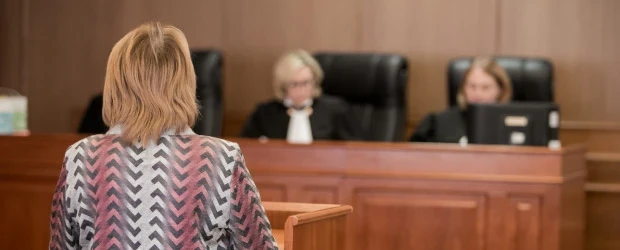In 1996 Congress passed the Prison Litigation Reform Act (PLRA) to decrease the instances of litigation brought to the courts from incarcerated people. For the 25 years since the PLRA was signed into law by President Clinton, prison reform and advocacy groups have challenged the act as another obstacle to justice for the nearly 2.3 million prisoners in the U.S.1, specifically by denying equal access to the courts of the United States.
What’s the Purpose of the Prison Litigation Reform Act?
The PLRA mandates a number of requirements and restrictions be applied to lawsuits brought by prisoners in the federal courts. What’s the issue with this? As the Supreme Court stated, “What for a private citizen would be a dispute with his landlord, with his employer, with his tailor, with his neighbor, or with his banker becomes, for the prisoner, a dispute with the State.”2
In other words, if a prisoner in a state facility has an issue with their treatment, they’re forced to litigate the issue with the perpetrators of the alleged mistreatment and prevented from getting outside authorities, the federal courts, involved. The containment of these cases within the jails and prisons themselves could mean that important civil rights abuses are covered up by the institutions that committed them.
How hard is it for a prisoner to bring a case to federal court?
Some of the most controversial obstacles enacted by the PLRA include:
The Exhaustion of Remedies Requirement
Before a prisoner may file a lawsuit in court, they must first take their complaints through all levels of the prison’s or jail’s particular grievance system and comply with all deadlines and other procedural rules of that system.3 These grievance systems often include tight deadlines, complicated administrative hoops and strict technical requirements which, if not met, will result in a case being thrown out before it even proceeds through the grievance process.
For example, in 2013, one prisoner’s grievance was denied when he submitted an internal grievance appeal using handwritten copies of prior appeals (rather than the required photocopies), without informing prison authorities that the photocopier was broken.4 Another case was dismissed because the plaintiff filed one grievance of mistreatment for three issues (chemical weapons while restrained, assault with a riot stick and chemical agent, and denial of medical attention) together, instead of filing separate grievances for each of his complaints.5
The Physical Injury Requirement
The Physical Injury Requirement states that a prisoner may not recover financial compensation for “mental or emotional injury”6 unless they make a “prior showing of physical injury.” For example, unless a prisoner was able to demonstrate physical injury from an attack or sexual assault, they would not be able to recover compensation for the resulting mental trauma of the incident.
The Prison Policy Institute, a non-profit advocacy group, explains that in many cases courts have also found that this provision applies even to Constitutional claims including violations of, free speech, religious freedom, discrimination, and due process, thereby denying incarcerated people the ability to seek financial compensation for the violation of their Constitutional rights.7
Further, the research and advocacy group Human Rights Watch points out that because of this provision, many of the abuses that took place in Iraq’s Abu Ghraib prison would not have been compensable if they had occurred in a US prison or jail.8
The Three Strikes Provision
Incarcerated individuals are denied waivers for federal filing fees and must pay a $350 fee for filing a case. In most situations, incarcerated people are permitted to pay these fees in installments over time. However, the PLRA’s Three Strikes Rule states that if an incarcerated plaintiff files three claims that a judge decides are frivolous, malicious, or do not state a proper claim, incarcerated plaintiffs can then be required to pay fees upfront for further claims. The Three Strikes Rule essentially makes filing lawsuits financially out of reach for nearly all the affected individuals as most prisoners make on average less than a dollar an hour9 and would have a difficult time obtaining the funds.
Limitations to Attorney Fees
Another financial obstacle presented by the PLRA is that it discourages attorneys from taking on cases of incarcerated persons by limiting the amount they can be paid.
Even if a prisoner manages to file a lawsuit and wins, establishing that their rights have been violated, the PLRA caps recoverable attorneys’ fees at a below-market rate, and insists that these fees total no more than 150% of any damages awarded to the plaintiff.10 Between these limits and the fact that damages granted to incarcerated people are generally quite low, attorneys are disincentivized to take on prisoner’s cases forcing the incarcerated to represent themselves in court.
The PLRA Applies to Incarcerated Children
Each of the above requirements and other provisions of the PLRA apply not only to adult prisoners, but also to children confined in prisons, jails, and juvenile detention facilities.11 Further, court rulings have determined that efforts made to meet the Exhaustion of Remedies requirement cannot be completed on a child’s behalf by their parents or other adults.7
What can be done to repeal the PLRA and bring reform to prisons?
Education and awareness are two first steps to healing a lot of issues within the U.S. prison complex. If you’re interested in digging deeper into the PLRA, prison reform, and alternatives to the prison system, consider pursuing a secondary degree that can help you on your path to fighting criminal justice.
The M.A. in Criminology and Criminal Justice from Kent State helps prepare you for the diverse career paths associated with criminology, or the theoretical exploration of crime, as well as the practical application and execution of criminal justice policies.
Sources
- Retrieved on July 30, 2021 from prisonpolicy.org/blog/2020/01/16/percent-incarcerated/
- Retrieved on July 22, 2021 from supreme.justia.com/cases/federal/us/411/475/#500
- 42 United States Code (U.S.C.) sec. 1997e(a).
- Retrieved on July 22, 2021 from law.justia.com/cases/federal/appellate-courts/ca3/11-3019/11-3019-2013-09-16.html
- Retrieved on July 22, 2021 from courtlistener.com/docket/5292770/26/brockington-v-duncan/
- 42 U.S.C. sec. 1997e(e)
- Retrieved on July 22, 2021 from prisonpolicy.org/reports/PLRA_25.html
- Retrieved on July 22, 2021 from hrw.org/report/2009/06/16/no-equal-justice/prison-litigation-reform-act-united-states#_ftn7
- Retrieved on July 22, 2021 from prisonpolicy.org/blog/2017/04/10/wages/
- Retrieved on July 22, 2021 from www.law.cornell.edu/uscode/text/42/1997e
- 18 U.S.C. sec. 3626(g)(3) and (5); 42 U.S.C. sec. 1997e(h)




